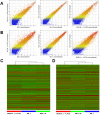Identification of Differentially Expressed Long Non-coding RNAs in Polarized Macrophages
- PMID: 26796525
- PMCID: PMC4726337
- DOI: 10.1038/srep19705
Identification of Differentially Expressed Long Non-coding RNAs in Polarized Macrophages
Abstract
Macrophages display remarkable plasticity, with the ability to undergo dynamic transition between classically and alternatively activated phenotypes. Long non-coding RNAs (lncRNAs) are more than 200 nucleotides in length and play roles in various biological pathways. However, the role of lncRNAs in regulating macrophage polarization has yet to be explored. In this study, lncRNAs expression profiles were determined in human monocyte-derived macrophages (MDMs) incubated in conditions causing activation toward M(IFN-γ + LPS) or M(IL-4) phenotypes. Compared with primary MDMs, 9343 lncRNAs and 5903 mRNAs were deregulated in M(IFN-γ + LPS) group (fold change ≥ 2.0, P < 0.05), 4592 lncRNAs and 3122 mRNAs were deregulated in M(IL-4) group. RT-qPCR results were generally consistent with the microarray data. Furthermore, we found that TCONS_00019715 is expressed at a higher level in M(IFN-γ + LPS) macrophages than in M(IL-4) macrophages. TCONS_00019715 expression was decreased when M(IFN-γ + LPS) converted to M(IL-4) whereas increased when M(IL-4) converted to M(IFN-γ + LPS). Knockdown of TCONS_00019715 following the activation of THP-1 cellls using IFN-γ and LPS diminished the expression of M(IFN-γ + LPS) markers, and elevated the expression of M(IL-4) markers. These data show a significantly altered lncRNA and mRNA expression profile in macrophages exposure to different activating conditions. Dysregulation of some of these lncRNAs may play important roles in regulating macrophage polarization.
Figures





Similar articles
-
Long Noncoding RNA Profiling from Fasciola Gigantica Excretory/Secretory Product-Induced M2 to M1 Macrophage Polarization.Cell Physiol Biochem. 2018;47(2):505-522. doi: 10.1159/000489984. Epub 2018 May 22. Cell Physiol Biochem. 2018. PMID: 29794463
-
Regulation of Macrophage Activation and Polarization by HCC-Derived Exosomal lncRNA TUC339.Int J Mol Sci. 2018 Sep 28;19(10):2958. doi: 10.3390/ijms19102958. Int J Mol Sci. 2018. PMID: 30274167 Free PMC article.
-
Differential Expression of Long Noncoding RNAs During Cardiac Allograft Rejection.Transplantation. 2017 Jan;101(1):83-91. doi: 10.1097/TP.0000000000001463. Transplantation. 2017. PMID: 27575691
-
Long non-coding RNAs as the regulators and targets of macrophage M2 polarization.Life Sci. 2021 Feb 1;266:118895. doi: 10.1016/j.lfs.2020.118895. Epub 2020 Dec 10. Life Sci. 2021. PMID: 33310042 Review.
-
Long non-coding RNAs regulating macrophage functions in homeostasis and disease.Vascul Pharmacol. 2019 Mar;114:122-130. doi: 10.1016/j.vph.2018.02.011. Epub 2018 Mar 13. Vascul Pharmacol. 2019. PMID: 29548902 Free PMC article. Review.
Cited by
-
Long non-coding RNA FENDRR regulates IFNγ-induced M1 phenotype in macrophages.Sci Rep. 2020 Aug 13;10(1):13672. doi: 10.1038/s41598-020-70633-7. Sci Rep. 2020. PMID: 32792604 Free PMC article.
-
LncGBP9/miR-34a axis drives macrophages toward a phenotype conducive for spinal cord injury repair via STAT1/STAT6 and SOCS3.J Neuroinflammation. 2020 Apr 28;17(1):134. doi: 10.1186/s12974-020-01805-5. J Neuroinflammation. 2020. PMID: 32345320 Free PMC article.
-
Roles of long noncoding RNAs in human inflammatory diseases.Cell Death Discov. 2024 May 15;10(1):235. doi: 10.1038/s41420-024-02002-6. Cell Death Discov. 2024. PMID: 38750059 Free PMC article. Review.
-
Identification of Differentially Expressed lncRNAs in a CpG ODN-Activated Macrophage.J Immunol Res. 2020 Jun 13;2020:1407654. doi: 10.1155/2020/1407654. eCollection 2020. J Immunol Res. 2020. PMID: 32626785 Free PMC article.
-
Long non-coding RNA LINC01627 is a prognostic risk factor for epithelial ovarian cancer.Oncol Lett. 2019 Sep;18(3):2861-2868. doi: 10.3892/ol.2019.10661. Epub 2019 Jul 24. Oncol Lett. 2019. PMID: 31452765 Free PMC article.
References
Publication types
MeSH terms
Substances
LinkOut - more resources
Full Text Sources
Other Literature Sources

